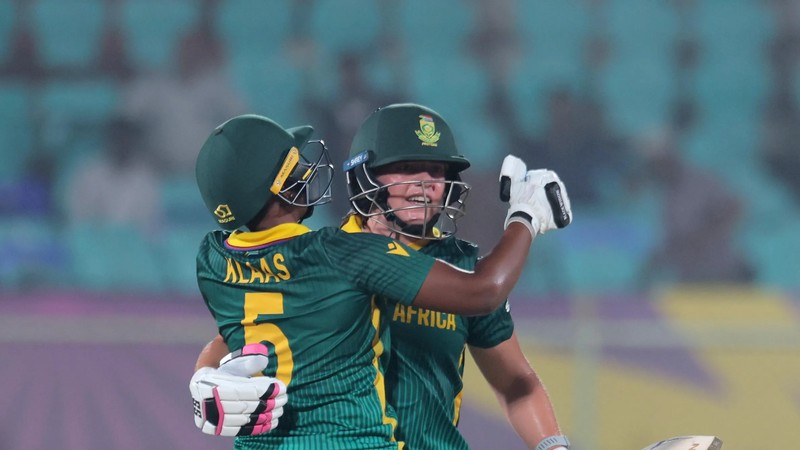The Proteas are two matches away from glory.
It could be their good fortune to be playing England, their familiar rivals, in the World Cup semi-final on Wednesday, because it will be the third consecutive time they meet at this juncture. And everyone knows what they say about being third time lucky and all of that …
Or it could be their misfortune to be meeting a team who bowled them out for just 69 before trouncing them by 10 wickets in the opener almost a month ago now.
In that game Nadine de Klerk formed part of the Proteas’ batting malaise with the all-rounder managing just three off 11 balls before edging Sophie Ecclestone to slip. Since then, De Klerk has faced a further 122 balls, smashed 176 runs, which includes 17 boundaries and a whopping 10 sixes, at a tournament best strike-rate of 144.26.
It has been a dramatic turnaround for the previously nondescript all-rounder, which has not only transformed her team’s fortunes by almost single-handedly winning two matches en route to the semi-final, but also elevated her to the lofty status as one of the competition’s most feared ball strikers.
De Klerk’s metamorphosis into a hulking superhero may have caught many by surprise with all the focus leading into this World Cup being on top-order batters Laura Wolvaardt, Tazmin Brits and Marizanne Kapp, but team batting coach Baakier Abrahams has seen De Klerk along with fellow Proteas’ ‘finisher’ Chloe Tryon bubbling under in the team’s preparation readying themselves to explode at the showpiece.
“We’ve got game winners across the lineup. But obviously, we’ve got a style of play, we understand what makes us tick, how we really function, and what gets the best out of everyone,” Abrahams said at the SuperSport ICC Women’s World Cup Virtual Round Table.
“We definitely don’t think she’s a number eight. I think she’s got potential, but this is where the team needs her right now.
“She’s really good at what she does and that’s our point of difference. That’s what she brings to this side that makes us really unique and really difficult to beat.
Fresh off her heroic match-winning knock against the India Women last night, we caught up with Nadine de Klerk for her thoughts! 💬🇿🇦#Unbreakable #CWC25 pic.twitter.com/dnjOzxp1RK
— Proteas Women (@ProteasWomenCSA) October 10, 2025
“I think the calmness that in the build up to this competition, we’ve always spoken about her and Chloe (Tryon), if one of them are not out at the end, or both, we’re generally going to end up on the right side of the result, just purely because of how dynamic they are.
“We’ve really worked on what that looks like from a responsibility point of view, because they’ve always had the explosiveness, the power, the tactical acumen.
“It’s now just they’re able to actually put it together in a game under pressure. And that’s sort of been the real standout thing for me, how they’ve sort of matured.”
Abrahams has worked tirelessly with De Klerk to equip the 25-year-old with the necessary skills to be successful in high-pressure situations such as the death overs of run-chase, which could yet be called on in the clutch moments in Guwahati again on Wednesday.
“From a game perspective and development point of view, I think when you’re coming from a batting coach, you look at sort of her existing career,” Abrahams said.
“You look at where she scores. You then try and find technically, is there maybe one or two adjustments you can add to make it even better?
A World Cup to Remember. 🌍🏆
From unforgettable wins to special team moments, #TheProteas Women share their favourite memories from #CWC25 so far. 💚💛 #Unbreakable pic.twitter.com/f9XZdFch3O
— Proteas Women (@ProteasWomenCSA) October 28, 2025
“Tactically, is there certain scoring areas that maybe she isn’t accessing that is maybe making it a little bit easier for teams to maybe bowl to her. Once she starts opening up these new areas of scoring, they are not sure which way to go. I think that’s sort of been her evolution from both a tactical point of view and technical point of view.
“But again, she’s really matured from a finisher point of view in terms of staying calm and a mentality that’s required to bat in those situations because there is extreme pressure. You can’t get out and you’ve got to score quickly and to be able to come through all of that, it just shows sort of the strides she’s made.”
